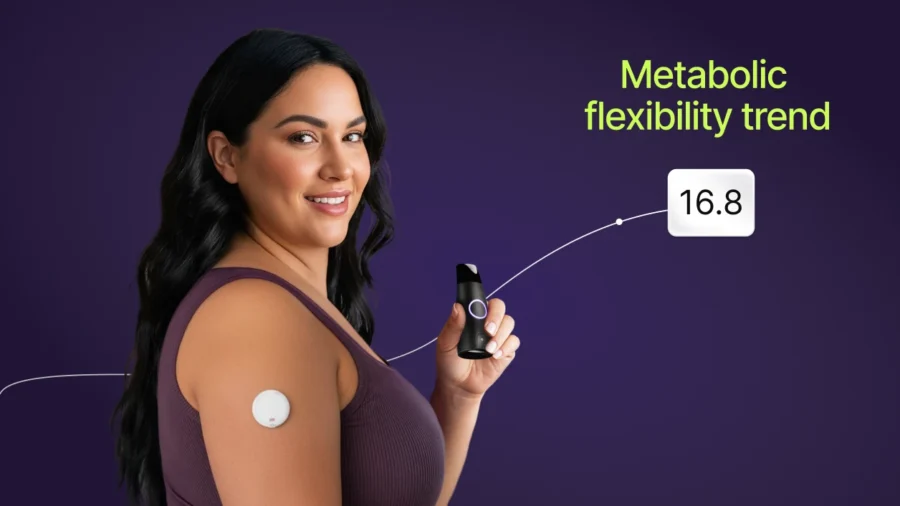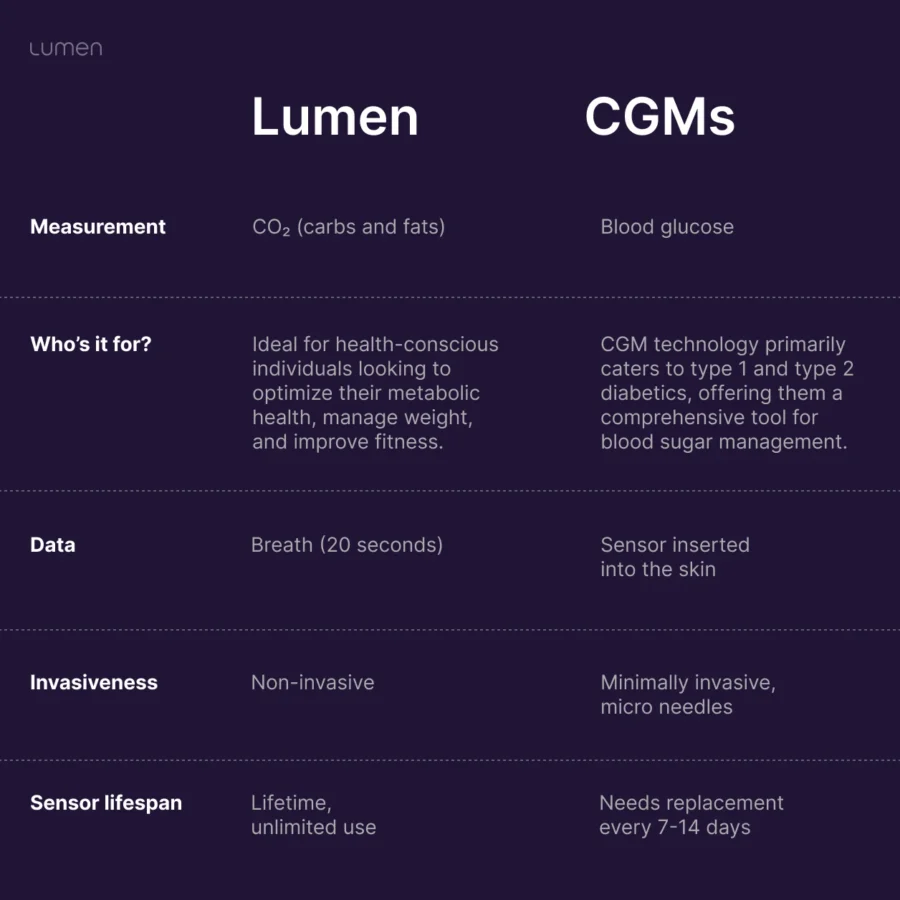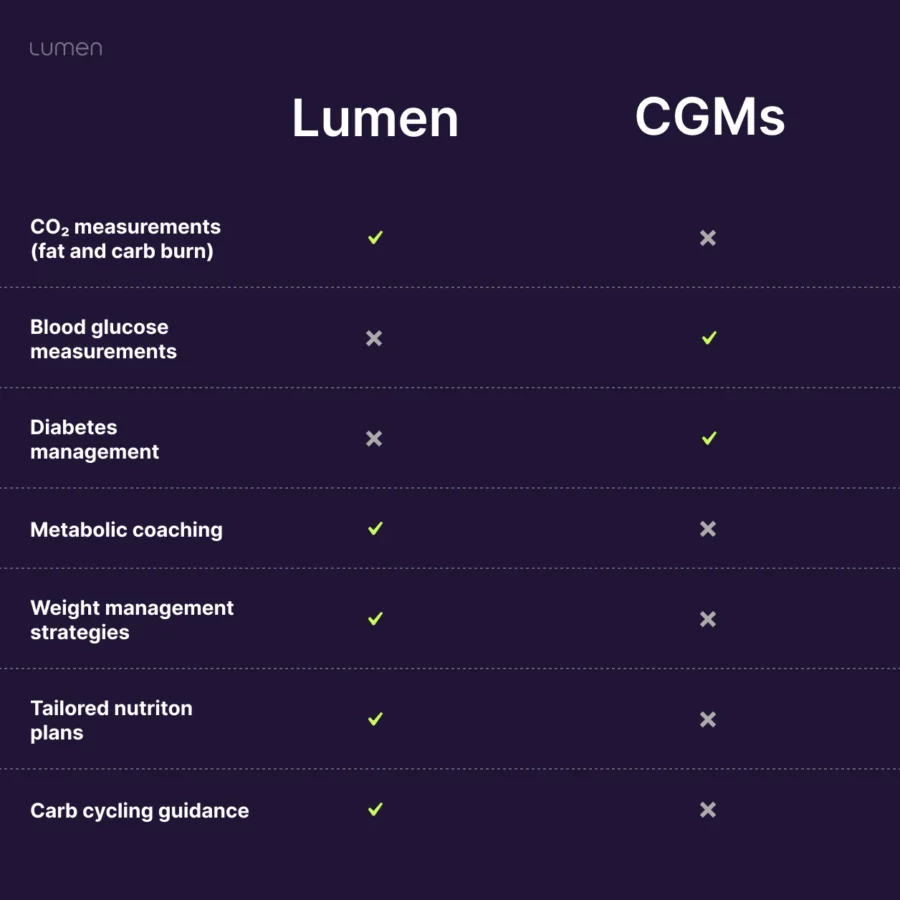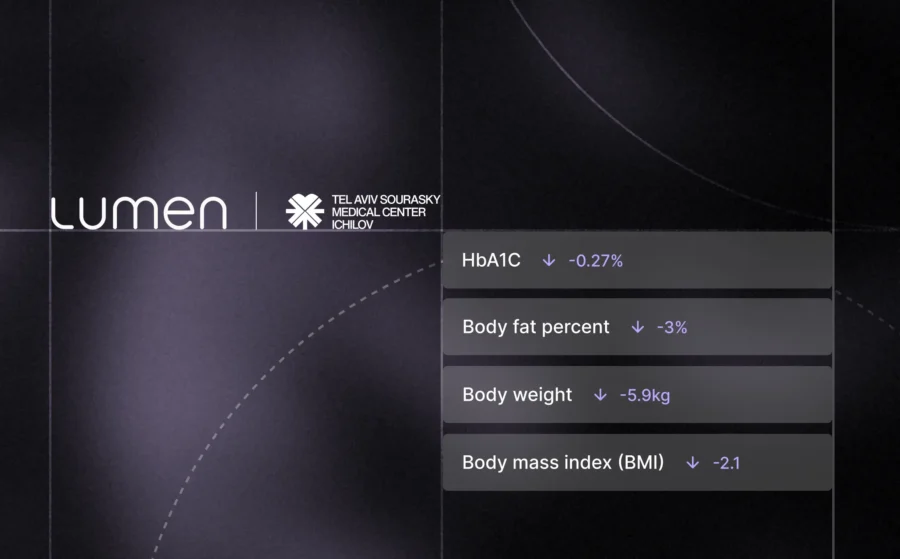Lumen vs. continuous glucose monitors (CGMs): Which metabolism tracker is right for you?

You may have noticed that in recent years, personalized health and wellness tools that offer real-time insights into your body’s metabolic processes have gained immense popularity. Two leading technologies in this space are continuous glucose monitors (CGMs) and Lumen, a portable metabolic tracker.
Both tools provide valuable information, but serve different purposes in tracking and optimizing your metabolism. Let’s dive into the key differences, benefits, and how you might use these tools to boost your metabolism and achieve your health goals.
What is a continuous glucose monitor (CGM), and what does it do?
A CGM is a small, wearable device that measures glucose levels in your interstitial fluid throughout the day. By providing continuous data, a CGM gives you a detailed picture of how various factors like food, exercise, and stress impact your blood glucose levels. Unlike finger-prick blood glucose monitors, CGMs offer a hands-free and comprehensive way to monitor glucose trends in real time.
Benefits of a CGM
- Real-time glucose monitoring: Get immediate feedback on how specific foods and activities affect your blood sugar. Identify patterns that may indicate insulin resistance or prediabetes [1].
- Dietary insights: Learn which foods stabilize your glucose levels and which cause spikes.
- Diabetes management: Individuals with diabetes can manage their condition through timely data on glucose trends.
- Insulin management: For individuals on insulin therapy, CGM assists in fine-tuning insulin doses for better glycemic control.
CGMs are particularly popular among individuals managing diabetes, but they’re increasingly being used by health enthusiasts looking to optimize their metabolism and performance [2].

What is Lumen, and what does it do?
Lumen is a handheld metabolic tracker that identifies whether you’re burning carbohydrates or fat for energy and allows you to adjust your nutrition and exercise routines in real time to achieve better metabolic flexibility over time.
It does this by measuring the concentration of carbon dioxide in your breath using technology similar to that of the metabolic cart, a device traditionally used in clinical settings.
When you’re metabolically flexible, your mitochondria, which are your cells’ powerhouses, can easily switch between burning carbs and fats for energy.
Metabolic flexibility is crucial for:
- Sustaining energy levels throughout the day.
- Losing weight and keeping it off.
- Enhancing athletic performance and maintaining muscle mass.
- Improving overall metabolic health and reducing the risk of metabolic diseases [3].
Research links impaired metabolic flexibility to metabolic syndrome and chronic diseases, including type 2 diabetes, cardiovascular disease (CVD), and neurodegenerative disease.
Regularly using Lumen can train your body to become more metabolically flexible and efficient. Users can measure their wake-up breath, pre/post-meal breath, pre/post-workout breath, and more, which provide personalized recommendations based on live metabolic data.

“I have been training my metabolic flexibility for close to a year now. I have lost 42 pounds in eleven months, and I am happier, healthier, exercise more, and feel more confident.”
- Stephanie, 42, Ohio, Lumen user
Benefits of Lumen
- Metabolic awareness: Lumen measures exhaled CO2 levels, offering insights into whether you’re burning carbs or fats in real time [4].
- Customized lifestyle strategies: With Lumen, you can get personalized meal recommendations and lifestyle suggestions based on your metabolic state.
- Weight management: Lumen aids in weight loss and management by guiding you toward better metabolic health via tailored nutrition, exercise, sleep, and stress management recommendations.
- Better athletic performance: Measuring your metabolism before a workout identifies whether you’re burning carbs or fats, which helps you fuel properly to increase energy, avoid burnout, and preserve muscle mass.
- Upgrading sleep and energy: Metabolic measurements can show if your metabolism is out of balance, which could affect sleep quality and energy levels. Lumen provides lifestyle changes, like adjusting carb timing, to boost your energy levels and well-being.
- Personalized fasting: Lumen lets you identify your ideal fasting window. Different fasting windows affect whether your body burns fat or carbs, and knowing when to stop fasting can help you avoid muscle breakdown.
- Early disease detection: Consistently waking up in carb burn could signal potential metabolic issues like insulin resistance or metabolic syndrome. Regular monitoring can help you adjust lifestyle habits to improve insulin sensitivity and metabolic flexibility and prevent health problems from escalating.
- Long-term health: Lumen’s weekly Flex Score empowers you to track and improve your metabolic flexibility over time, boosting longevity.
A day in the life using Lumen
Here’s how you might use Lumen throughout the day to optimize your metabolism:
1. Wake-up breath
Start your day with a wake-up breath measurement to understand your baseline metabolic state. Your Lumen device will give you a score from 1 to 5 to indicate whether you are burning fat after an overnight fast.
Waking up in fat burn signals healthy mitochondria and balanced habits. A carb-burn reading may suggest areas to adjust, from nutrition and sleep hygiene to stress and activity, and can help pinpoint why you’re waking up tired and struggling to lose weight.
2. Pre-meal and post-meal breath
Your pre-meal breath can reveal your current glycogen levels, helping you figure out how many carbs to eat at your next meal.
Glycogen levels depend on your carb intake and energy use. When glycogen is high, your mitochondria focus on burning carbs. If you eat more carbs than your glycogen stores can hold, the excess is stored as fat.
If you’re burning mostly carbs before a meal, your glycogen stores are likely full. Choose a low-carb meal with protein, healthy fats, and veggies to avoid glycogen overload and weight gain. If your pre-meal breath shows fat burn or a fat-carb mix, your glycogen stores aren’t full. You can eat carbs, if you’d like, without risking overload.
Take a post-meal breath 45–90 minutes after eating to see how your body responds to the meal. Your shift to carb burn may be sharp or gradual.
In a retrospective study by Lumen with 2,607 participants, people with a healthy BMI and better metabolic flexibility demonstrated a greater post-meal carb response, burning more of the carbs they ate for energy rather than storing them as fat [5].
This aligns with results from our latest Lumen Experiments, involving 2,700 Lumen community members, which showed that participants with a BMI of 18.5–25 demonstrated:
- A faster and stronger carb response after eating. This means they are more likely to use the carbs they eat for energy rather than store them as fat.
- Higher CO2 levels even 2+ hours after eating, indicating more metabolic activity.
3. Pre-workout and post-workout breath
Take a pre-workout breath measurement to determine if you should fuel up before your high-intensity workout. If you’re burning fat, that’s a sign your glycogen stores are low, and you should eat a fast-digesting carbohydrate source like a banana to avoid muscle breakdown.
Take a metabolic measurement again 30–45 minutes following your workout, after your heart rate has stabilized. This measurement gauges how intense your exercise was and how well your body is recovering.
During high-intensity workouts like sprinting or weightlifting, your mitochondria rely on carbs for a quick and powerful energy boost. Afterward, your body enters a recovery phase, replenishing glycogen stores and repairing muscle tissue. During this time, it burns mostly carbs.
Once you’ve shifted to fat burn, it means recovery is complete. A longer shift back to fat burn means you had an intense workout.
4. Fasting breath
Measure your metabolism to know when to break your fast. Begin by measuring your metabolism when you first wake up to establish a baseline and determine whether you’re burning carbs or fats for fuel.
Continue measuring your metabolism every hour. The goal is to remain at level 1 or 2, which indicates fat burn. During a fast, your mitochondria should be burning fat for fuel.
When you shift towards carb burn (level 4 or 5), this indicates you should break your fast, as your glycogen stores are getting critically low and leading your body to break down muscle for energy.
Can you use both Lumen and CGMs?
Absolutely. While CGMs and Lumen serve different purposes, they complement each other. Here’s how:
- Lumen for metabolic flexibility: Use Lumen to determine how your lifestyle habits are affecting your metabolic flexibility. This allows you to pinpoint what’s working and what’s not to maintain balanced energy levels, lose weight and keep it off, build and retain muscle mass, prevent metabolic syndrome, and maintain long-term health.
- CGM for glucose insights: Use a CGM to monitor how your blood sugar reacts to specific foods, workouts, or stress levels. This helps you maintain stable glucose levels, manage diabetes, and sustain energy.
Used with CGM measurements, Lumen helps complete the picture of how the body processes glucose after it exits the bloodstream. It can provide clarity into what happens after a CGM detects blood sugar spikes and whether glucose is being used efficiently as fuel. If you notice a high blood glucose spike in your CGM, measure your metabolism with Lumen to see your level of carb burn. Lumen’s study [5] showed that people with a healthy BMI have a higher CO2 response, indicating increased carb burn, when consuming a high-carb meal compared to obese people who have a low CO2 response, pointing to low metabolic flexibility.
Lumen also enables a big-picture view of users’ metabolic health status, providing weekly metabolic flexibility assessments. For example, constant blood glucose spikes, as seen in your CGM, can lead to insulin resistance over time, which can cause fat storage instead of fat burning and impair metabolic flexibility. This can be reflected as a lower Lumen Flex Score in the long term.
Together, both Lumen and CGMs provide a comprehensive view of your metabolism and empower you to make data-driven decisions about your well-being.
Which tool is right for you?
Both CGMs and Lumen represent the cutting edge of metabolic health technology. While each serves a unique purpose, their shared goal is to help you better understand your body and make smarter health decisions.
If you’re interested in weight management, knowing exactly when you’re burning fat, longevity, optimizing athletic performance, and discovering exactly how long to fast, Lumen is a game-changer. Its ability to provide real-time insights into your metabolic state makes it ideal for anyone looking to fine-tune their health and wellness routine.
A CGM may be helpful for individuals with diabetes or prediabetes or for those who’d like to stabilize their energy levels through dietary changes.
For anyone seeking a full-spectrum view of their metabolic health, Lumen offers unparalleled insights, helping you learn how to boost your metabolism, fuel your body efficiently, and achieve your health goals with precision.
Sources
- Manov, A. E., Chauhan, S., Dhillon, G., Dhaliwal, A., Antonio, S., Donepudi, A., Jalal, Y. N., Nazha, J., Banal, M., & House, J. (2023). The Effectiveness of Continuous Glucose Monitoring Devices in Managing Uncontrolled Diabetes Mellitus: A Retrospective Study. Cureus, 15(7), e42545. https://doi.org/10.7759/cureus.42545
- Rodbard D. (2017). Continuous Glucose Monitoring: A Review of Recent Studies Demonstrating Improved Glycemic Outcomes. Diabetes technology & therapeutics, 19(S3), S25–S37. https://doi.org/10.1089/dia.2017.0035
- Goodpaster, B. H., & Sparks, L. M. (2017). Metabolic Flexibility in Health and Disease. Cell metabolism, 25(5), 1027–1036. https://doi.org/10.1016/j.cmet.2017.04.015
- Lorenz, K. A., Yeshurun, S., Aziz, R., Ortiz-Delatorre, J., Bagley, J. R., Mor, M., & Kern, M. (2021). A Handheld Metabolic Device (Lumen) to Measure Fuel Utilization in Healthy Young Adults: Device Validation Study. Interactive journal of medical research, 10(2), e25371. https://doi.org/10.2196/25371
- Yeshurun, S., Cramer, T., Souroujon, D., & Mor, M. (2024a). The Association of Macronutrient consumption and BMI to exhaled carbon dioxide in lumen users: Retrospective real-world study. JMIR mHealth and uHealth, 12. https://doi.org/10.2196/56083







 Digital download
Digital download 


